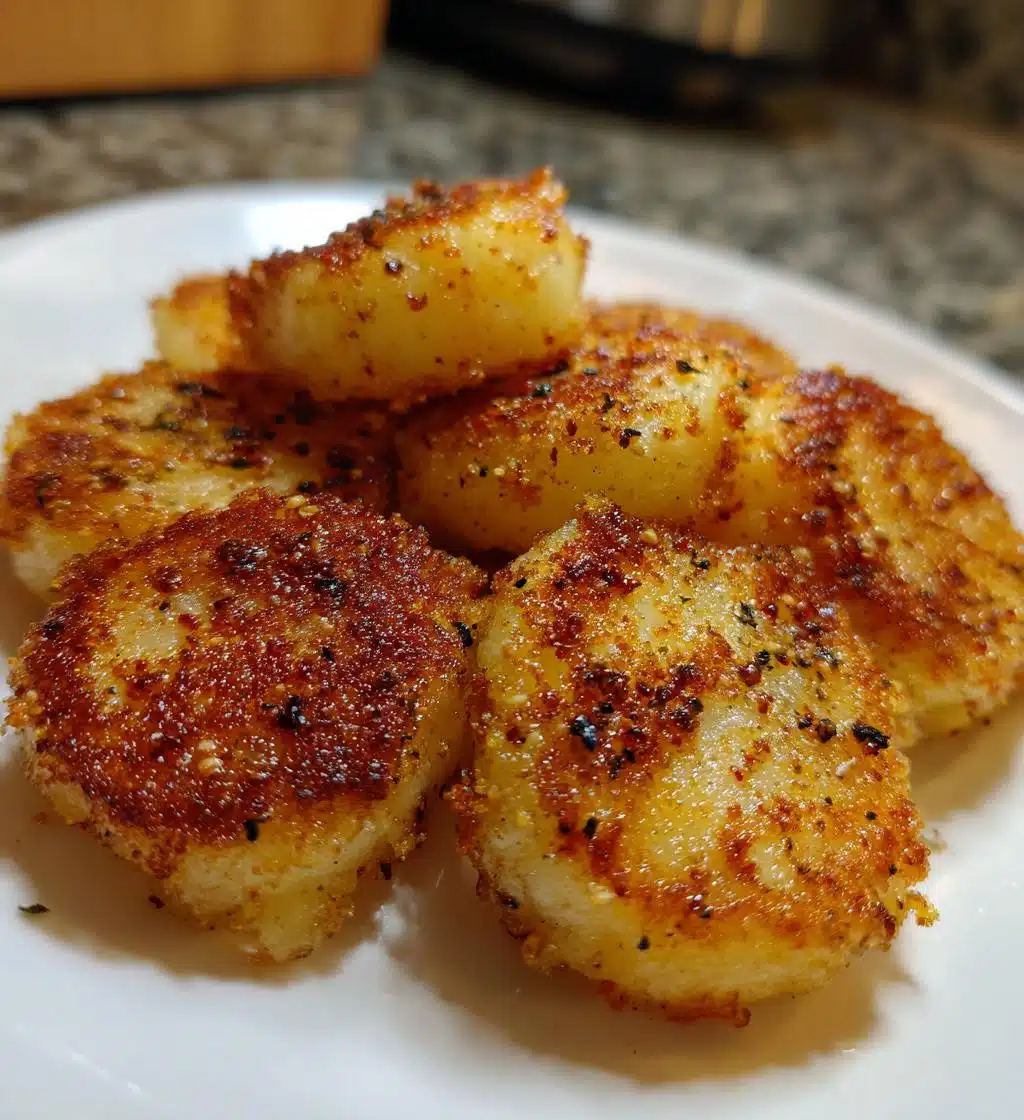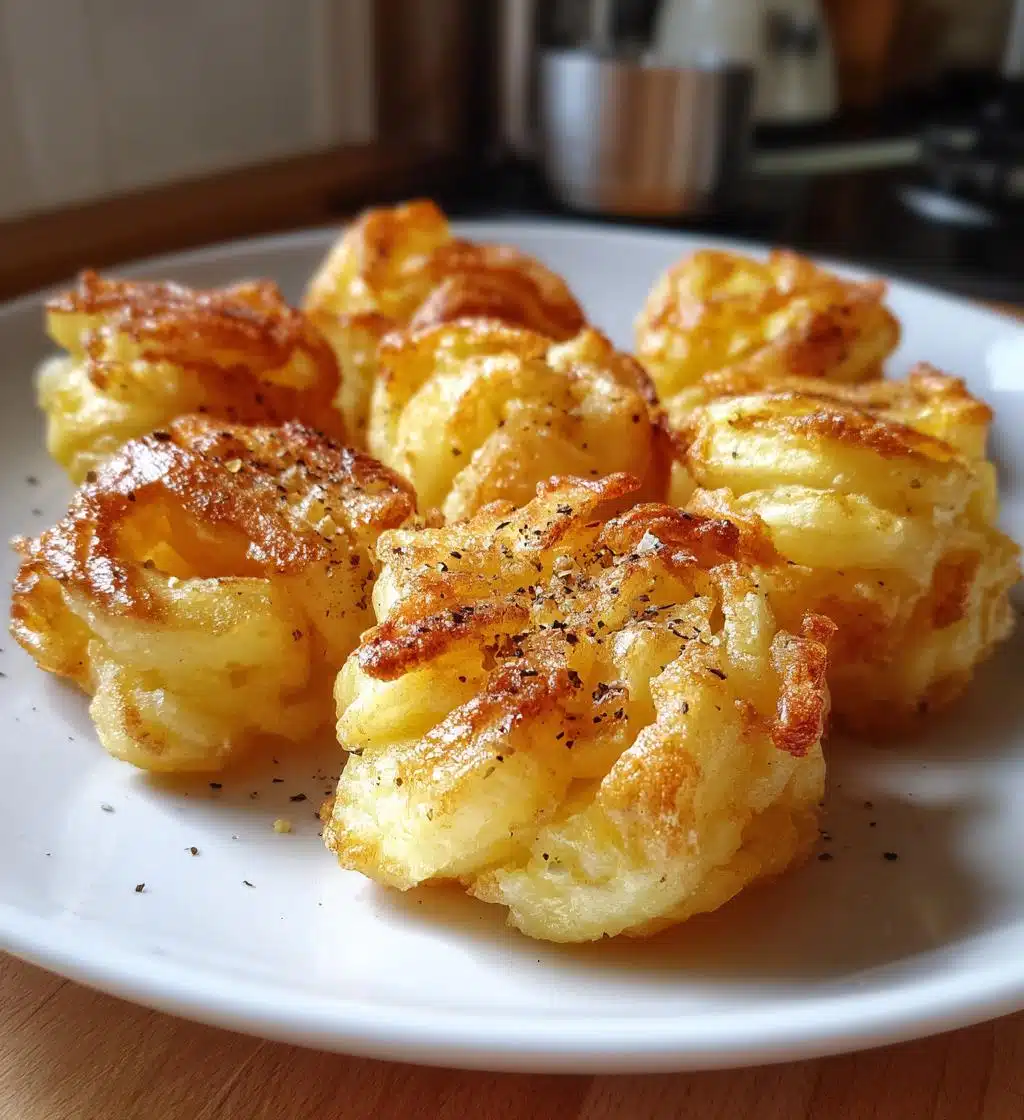Oh, let me tell you about German schupfnudeln! These delightful potato noodles are like a warm hug on a plate. Growing up, my family made them for every special occasion, and I can still remember the comforting aroma wafting through the kitchen as they fried to golden perfection. They’re not just any noodles—they’re incredibly versatile! You can serve them as a savory side with meats or toss them with some sautéed veggies for a delightful main course. Trust me, once you take a bite, the creamy texture combined with that buttery crispiness will make your taste buds dance! They’re simple to whip up, yet they bring such joy to the table. Seriously, these noodles have a way of bringing everyone together—it’s like magic!
Ingredients List
- 500g potatoes, peeled and diced
- 150g all-purpose flour
- 1 large egg
- Salt to taste
- Pepper to taste
- Butter for frying, about 2 tablespoons
How to Prepare German Schupfnudeln
Step-by-Step Instructions
- Start by bringing a large pot of salted water to a boil. You’ll want it bubbling away!
- Once the water is boiling, add your peeled and diced potatoes. Boil them for about 20 minutes or until they’re fork-tender. Trust me, you want them soft so they mash easily!
- Drain the potatoes and let them cool for a few minutes. Then, while they’re still warm, peel off the skins and mash them in a bowl until smooth. You can use a potato masher or even a ricer if you have one—just make sure there are no lumps!
- Now it’s time to make the dough! Add the flour, egg, salt, and pepper to the mashed potatoes. Mix everything together until a smooth dough forms. It should be soft but not sticky—if it’s too sticky, sprinkle in a bit more flour.
- On a lightly floured surface, take portions of the dough and roll them into small noodles, about 2 inches long. Don’t worry about making them perfect; a little rustic charm adds to their character!
- In a large skillet, melt some butter over medium heat. Once it’s nice and bubbly, add the noodles in batches. Fry them for about 5-7 minutes on each side or until they’re golden brown and crispy. Ooh, that smell is heavenly!
- Once fried, remove them from the skillet and set them on a paper towel to absorb any extra butter. Serve them hot and watch them disappear!
Why You’ll Love This Recipe
- Quick and easy preparation—perfect for a weeknight dinner!
- Deliciously fluffy potato noodles with a crispy golden exterior.
- Versatile dish that pairs wonderfully with meats, veggies, or even on their own!
- A comforting taste of traditional German cuisine right in your kitchen.
- Great for leftovers—just reheat and enjoy the next day!
- Kid-friendly and sure to please even the pickiest eaters.
Tips for Success
Getting your German schupfnudeln just right is all about a few simple tricks that make a big difference. Here are my top tips to help you nail this recipe:
- Choose the right potatoes: Go for starchy potatoes like Russets or Yukon Golds. They’re perfect for mashing and will give your noodles that light, fluffy texture we all love!
- Don’t skip the mashing: Make sure your potatoes are completely smooth before adding the other ingredients. Any lumps can lead to uneven noodles, and we don’t want that!
- Watch the dough consistency: The dough should be soft but not sticky. If it sticks to your fingers, sprinkle in a bit more flour until it’s manageable. Just don’t overdo it—too much flour can make the noodles dense.
- Fry on medium heat: Keep your skillet at medium heat to achieve that beautiful golden crust without burning them. If the heat is too high, you’ll get crispy outsides but raw insides. Patience is key!
- Fry in batches: Don’t overcrowd the pan! Frying in small batches allows for even cooking and helps the noodles get that lovely crispiness all around.
- Let them rest: After frying, place the noodles on paper towels to absorb excess butter. This little step helps keep them from getting soggy.
With these tips in your back pocket, you’re all set to create delicious schupfnudeln that will impress your family and friends. Happy cooking!
Serving Suggestions
Oh boy, when it comes to serving German schupfnudeln, the possibilities are endless! These little potato noodles are like a blank canvas, ready to soak up all the delicious flavors you throw their way. Here are some of my favorite pairings that truly elevate the meal:
- Sauerkraut: You can’t go wrong with traditional sauerkraut! The tangy crunch complements the creamy texture of the schupfnudeln beautifully. It’s a match made in heaven!
- Bratwurst or Sausages: If you’re in the mood for something heartier, serve them alongside grilled bratwurst or your favorite sausages. The savory flavors of the meat pair wonderfully with the noodles.
- Roasted Vegetables: For a lighter touch, toss together some roasted seasonal vegetables—like carrots, Brussels sprouts, or zucchini. The sweetness of the veggies contrasts perfectly with the richness of the noodles!
- Mushroom Cream Sauce: Drizzle a rich mushroom cream sauce over the noodles for a decadent experience. The earthy flavors from the mushrooms take them to another level!
- Simple Green Salad: Keep it fresh with a simple side salad dressed with a light vinaigrette. The crispness of the greens adds a refreshing balance to the dish.
Whether you choose a classic pairing or get a little creative, these German schupfnudeln will shine on your table. So, gather your loved ones, serve them up hot, and watch those smiles light up the room!
Storage & Reheating Instructions
Now, let’s talk about how to store those delicious German schupfnudeln once you’ve enjoyed your fill! If you happen to have leftovers (and that’s a big if because they’re so tasty!), you’ll want to keep them fresh and ready for round two.
- Storing: Allow the noodles to cool completely before transferring them to an airtight container. They’ll keep in the fridge for up to two days. Just be sure to separate layers with parchment paper if you’re stacking them—this helps prevent them from sticking together.
- Reheating: When you’re ready to dive back in, the best method is to reheat them in a skillet. Just melt a bit of butter over medium heat and add the schupfnudeln. Fry them for a few minutes until they’re heated through and crispy again. This little step brings back that lovely texture!
- Microwave Option: If you’re in a pinch and want a quicker option, you can use the microwave. Place them in a microwave-safe dish, cover with a damp paper towel, and heat in short bursts of 30 seconds, stirring in between. Just keep an eye on them so they don’t get rubbery!
With these easy storage and reheating tips, you can enjoy your German schupfnudeln even after the initial feast. Trust me, they’re just as good the next day, and you’ll definitely want to savor every last bite!
Nutritional Information
When it comes to enjoying German schupfnudeln, it’s always good to know what you’re putting on your plate! However, keep in mind that nutritional values can vary based on the specific ingredients and brands you use. The numbers below are typical values per serving (about 100g), so consider this a delicious guideline rather than a strict rule:
- Calories: 150
- Sugar: 1g
- Sodium: 10mg
- Fat: 5g
- Saturated Fat: 2g
- Unsaturated Fat: 3g
- Trans Fat: 0g
- Carbohydrates: 22g
- Fiber: 2g
- Protein: 4g
- Cholesterol: 30mg
So, whether you’re enjoying these delightful potato noodles as a comforting side or a main dish, you can feel good about what’s on your plate. They’re not just tasty, but also packed with goodness—perfect for sharing with family and friends!
FAQs
Can I make German schupfnudeln ahead of time?
Absolutely! You can prepare the dough a few hours in advance and keep it covered in the fridge. Just remember, the longer it sits, the more moisture it may absorb, so if it feels a bit dry when you’re ready to shape it, sprinkle in a touch more flour.
What type of potatoes work best for this recipe?
For the fluffiest schupfnudeln, I recommend using starchy potatoes like Russets or Yukon Golds. They mash beautifully and give the noodles that light texture we’re after!
Can I freeze German schupfnudeln?
Yes, you can! Just cook them first, let them cool completely, and then freeze in an airtight container. When you’re ready to enjoy them, reheat directly from frozen in a skillet with a bit of butter until heated through.
What can I serve with schupfnudeln?
The options are endless! They pair wonderfully with sauerkraut, sausages, or even a rich mushroom cream sauce. You can also toss them with sautéed veggies for a lighter meal!
Why did my schupfnudeln turn out dense?
If your noodles are dense, it’s likely due to too much flour in the dough or not mashing the potatoes thoroughly. Make sure they’re super smooth before mixing in the flour, and keep an eye on the dough consistency!

German Schupfnudeln: 7 Secrets to Perfectly Crisp Noodles
- Total Time: 50 minutes
- Yield: 4 servings 1x
- Diet: Vegetarian
Description
Schupfnudeln are traditional German potato noodles, often served as a side dish or main course.
Ingredients
- 500g potatoes
- 150g flour
- 1 egg
- Salt to taste
- Pepper to taste
- Butter for frying
Instructions
- Boil the potatoes until tender.
- Peel and mash the potatoes.
- Mix in flour, egg, salt, and pepper to form a dough.
- Shape the dough into small noodles.
- Fry the noodles in butter until golden brown.
Notes
- Serve with sauerkraut or as a side to meats.
- Store leftovers in the fridge for up to two days.
- Reheat in a pan for best texture.
- Prep Time: 20 minutes
- Cook Time: 30 minutes
- Category: Side Dish
- Method: Boiling and frying
- Cuisine: German
Nutrition
- Serving Size: 100g
- Calories: 150
- Sugar: 1g
- Sodium: 10mg
- Fat: 5g
- Saturated Fat: 2g
- Unsaturated Fat: 3g
- Trans Fat: 0g
- Carbohydrates: 22g
- Fiber: 2g
- Protein: 4g
- Cholesterol: 30mg
Keywords: german schupfnudeln, potato noodles, traditional german food


